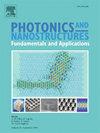Manipulation of the magnetic dipole and electric dipole emissions by the TiO2:Eu3+ inverse opal photonic crystals
IF 2.5
3区 物理与天体物理
Q3 MATERIALS SCIENCE, MULTIDISCIPLINARY
Photonics and Nanostructures-Fundamentals and Applications
Pub Date : 2025-02-01
DOI:10.1016/j.photonics.2025.101365
引用次数: 0
Abstract
The TiO2:Eu3+ inverse opals have the anatase structure and can be analyzed approximately by the two-dimensional photonic crystal. The emission spectra of the Eu3+ ions in the TiO2:Eu3+ inverse opal demonstrate that the inverse opal has significant manipulation effect on the emission of the Eu3+ ions. With the polystyrene (PS) microsphere size of 300 nm, the emission intensity ratio of the magnetic dipole transition 5D0→7F1 to the electric dipole transition 5D0→7F2 increases by about 4.9 times in the TiO2:Eu3+ inverse opal in comparison with the reference TiO2:Eu3+ nanomaterials sample, meanwhile the electric dipole emission 5D0→7F4 at 695 nm also increases significantly. With the deviation of the PS microsphere size, the above manipulation effect also decreases. The theoretical analysis implies that the above manipulation is mainly due to the forbidden photonic band of the TE mode in the TiO2:Eu3+ inverse opal, which results in the decrease of the electric local density of state in the forbidden photonic band and the decrease of the emission 5D0→7F2, on the contrary, the corresponding emissions 5D0→7F1 and 5D0→7F4 will increase.
TiO2:Eu3+反蛋白石光子晶体对磁偶极子和电偶极子发射的操纵
TiO2:Eu3+反蛋白石具有锐钛矿结构,可以用二维光子晶体进行近似分析。TiO2:Eu3+反蛋白石中Eu3+离子的发射光谱表明,反蛋白石对Eu3+离子的发射有明显的操纵作用。当聚苯乙烯(PS)微球尺寸为300 nm时,TiO2:Eu3+反蛋白石中磁偶极子跃迁5D0→7F1与电偶极子跃迁5D0→7F2的发射强度比与参考TiO2:Eu3+纳米材料样品相比提高了约4.9倍,同时在695 nm处电偶极子发射5D0→7F4也显著提高。随着PS微球粒径的偏离,上述操作效果也随之降低。理论分析表明,上述操作主要是由于TiO2:Eu3+反蛋白石中TE模式的禁光子带,导致禁光子带中的电局域态密度降低,发射度5D0→7F2减小,相反,对应的发射度5D0→7F1和5D0→7F4会增加。
本文章由计算机程序翻译,如有差异,请以英文原文为准。
求助全文
约1分钟内获得全文
求助全文
来源期刊
CiteScore
5.00
自引率
3.70%
发文量
77
审稿时长
62 days
期刊介绍:
This journal establishes a dedicated channel for physicists, material scientists, chemists, engineers and computer scientists who are interested in photonics and nanostructures, and especially in research related to photonic crystals, photonic band gaps and metamaterials. The Journal sheds light on the latest developments in this growing field of science that will see the emergence of faster telecommunications and ultimately computers that use light instead of electrons to connect components.

 求助内容:
求助内容: 应助结果提醒方式:
应助结果提醒方式:


